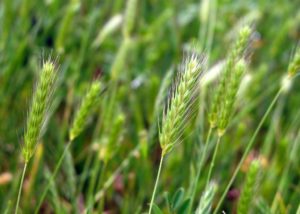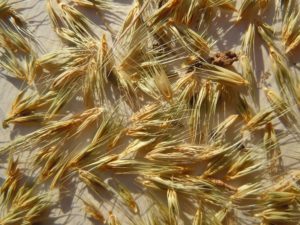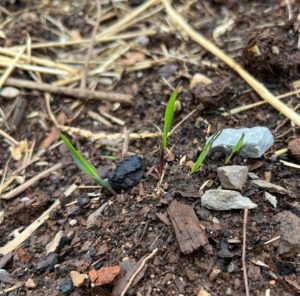
“Little barley” by M. McCraw, CC BY-NC-ND 2.0.
Corn, beans, and squash, the “Three Sisters” are typically the most common crops that come to mind when referencing indigenous American agriculture. However, long before the Three Sisters made their debut, the earliest farmers in the Eastern United States were cultivating plants such as Little Barley (Hordeum pusillum) – our March Plant of the Month! Native American women typically held the role of farmer, gatherer, and food processor, which also makes the discussion of Little Barley a meaningful contribution to Women’s History Month!
Characteristics:
The genus Hordeum belongs to the Poaceae plant family, otherwise known as the Grass Family. Members of this family characteristically have “knee-like” nodes/joints, hollow flower stems, and lack showy flower petals to attract insects because they are pollinated by wind instead. The modified bracts that surround the flower together make up the chaff that will be winnowed out of grain when harvested. Other examples of plants in the Grass Family include wheat, rice, corn, and rye. While some grasses like sugar cane and sorghum contain sugar at the base of the stalks in the roots, for most grasses only their immature seed heads are edible, but they provide many nutrients. Given that humans cannot digest cellulose, the only way for us to eat grasses as greens would be to chew them for the juice and then spit out the remaining plant fibers. The greatest threat to grasses to be wary of before harvest is the possibility of ergot fungus, which creates a black or purple powder when consuming grass seeds. The fungus can be extremely dangerous, with different species affecting the nervous system and restricting blood flow. In fact, ergot in grain storage is considered to be linked to the witch hunts of Salem, Massachusetts, in the 1600s!
Little Barley is a native tufted annual with culms (or stems) 4 to 24 inches tall, blades 1.25 to 5 inches long and 0.75 to 1.25 inches wide, and contains 3 spikelets per node. This grass has the potential to become weedy or invasive and thrives in disturbed areas such as overgrazed pastures and along roadsides. Little Barley grows in bunches and has a rapid growth rate, although it is intolerant of shade and droughts, requiring a medium amount of moisture. Its seeds ripen in late spring and last until early summer.

“Hordeum pusillum”, Matt Lavin, CC BY-SA 2.0.
Historical Uses:
Before the Three Sisters and more intensive agriculture, Native Americans domesticated plants such as gourd/squash (Cucurbita pepo), marshelder/sumpweed (Iva annua), sunflower (Helianthus annus), goosefoot (Chenopodium berlandieri) and cultivated plants such as maygrass (Phalaris caroliana) and little barley (Hordeum pusillum). This occurred as early as 5000-4000 years ago during the Late Archaic period and is evidenced by carbonized seeds in the archaeological record. Little Barley would have been cultivated as an important source of carbohydrates. Cultivation most likely began when the grain became a more important gathered resource; however, it is likely that many people continued to gather Little Barley in wild stands as well as utilized those that they grew in their personal gardens and fields. Little Barley would have been an important food crop given that it sets seed in late spring, when foods stored for winter would have been depleted and few other food crops are available. The grain was most likely parched to remove the chaff and then ground into a flour or meal to be added to stews and breads. The parching of the grain also allowed for extended storage.

Young Little Barley at our new Southern Foodways Garden, by Kandi Hollenbach.
Southern Foodways Garden:
Little Barley was chosen for March’s Plant of the Month because we have recently planted it, along with Maygrass seeds, in a new Southern Foodways Garden right next to the home of UTK’s Anthropology Department, Strong Hall. Make sure to follow the UTK Paleoethnobotany Facebook page for progress and updates!
For More Information:
Elpel, Thomas J.
1967 Botany in a Day: The Patterns Method of Plant Identification, An Herbal Field Guide to Plant Families of North America. HOPS Press. Pony, MT.
Scarry, C. Margaret
2003 Chapter 3, Patterns of Wild Plant Utilization in the Prehistoric Eastern Woodlands In People and Plants in Ancient Eastern North America. Smithsonian Books, Washington and London.
UDSA Plants Database
2022 Hordeum pusillum. National Plant Data Team, Greensboro, North Carolina. https://plants.sc.egov.usda.gov/core/profile?symbol=HOPU.
